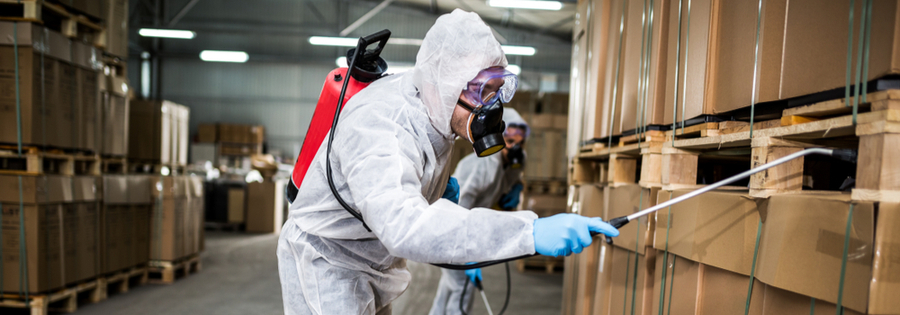A Comprehensive Overview to the Different Sorts Of Parasite Control Methods
Bug control is a crucial element of keeping a healthy and balanced and livable environment, whether it's in our homes, yards, or workplaces. With the myriad of parasite control approaches available, it can be overwhelming to find one of the most reliable solution for a specific pest problem. From chemical and biological methods to physical and natural options, each method has its very own special staminas and constraints. In this comprehensive overview, we will certainly explore these different sorts of bug control techniques, supplying understandings into their applications and benefits. By the end, you will have a more clear understanding of which technique might be the very best fit for your bug control requirements. So, allow's dive right into the fascinating world of parasite control and discover the secrets to a pest-free setting.
Chemical Bug Control Approaches

One common kind of chemical pest control is pesticides. Insecticides are chemical substances that are specifically developed to eliminate or drive away pests. They can be used in numerous forms, such as sprays, baits, or dusts. Pesticides target details bugs, such as insects, termites, or ants, and can be used both indoors and outdoors.
One more kind of chemical pest control is rodenticides. These are chemical substances designed to manage populations of rats, such as rats and mice. Rodenticides are generally used in bait kind, which brings in the rodents and then kills them after ingestion. They are typically utilized in agricultural settings, in addition to in residential and business buildings (Customized pest control solutions Chicago).
Weed killers, also called herbicides, are another kind of chemical pest control method. Herbicides are developed to precisely eliminate undesirable plants, understood as weeds, without causing injury to desirable plants. They are generally utilized in farming, landscape design, and horticulture to regulate the growth of unwanted plants.
While chemical pest control techniques can be very effective in removing bugs, it is very important to utilize them carefully and comply with safety standards. Overuse or abuse of chemical pesticides can have adverse influence on human health and wellness and the atmosphere. It is vital to employ these approaches responsibly and take into consideration alternate pest control methods whenever feasible.
Organic Pest Control Approaches
Biological insect control techniques entail making use of living microorganisms or all-natural compounds to manage and regulate pest populations. Unlike chemical techniques, which usually depend on artificial pesticides, organic control methods use the natural opponents of pests to regulate their populaces. This approach is considered even more eco friendly and sustainable, as it lowers using harmful chemicals and decreases the threat of chemical click this link resistance.
One widely utilized biological bug control technique is the intro of all-natural predators or parasites. Ladybugs are introduced to regulate aphids, while certain wasp types are launched to target caterpillars. These killers and bloodsuckers feed upon insects, decreasing their numbers and stopping problems.
One more biological control approach is using microorganisms. Certain microorganisms, infections, and fungi can be used to contaminate and kill particular pests. The microorganism Bacillus thuringiensis is typically utilized to control caterpillars, as it generates toxic substances that are lethal to these bugs.
Biological control techniques can also entail using pheromones or all-natural substances that disrupt the mating patterns of pests. By conflicting with their reproduction, these methods help to reduce pest populaces gradually.
While organic bug control techniques are normally effective, they may need longer durations to attain preferred results compared to chemical techniques. Additionally, careful consideration must be offered to the choice and release of natural opponents to avoid unintended damage to beneficial microorganisms or ecological communities.
Physical Bug Control Approaches
To efficiently manage and regulate pest populations, different insect control techniques called look at this now physical insect control approaches are utilized. These techniques include the usage of physical barriers, catches, or devices to avoid bugs from accessing or harming residential or commercial property. One common physical bug control method is the use of screens or nets to keep insects out of structures or yards. These screens are generally made from fine mesh material that enables air flow while preventing parasites from going into. Another physical bug control approach is the installment of fencings or walls to keep bigger pests, such as deer or rabbits, out of yards or agricultural fields. These obstacles physically block the bugs' accessibility to the area, minimizing the potential for damage. Furthermore, catches and devices can be made use of to capture or drive away bugs. As an example, sticky catches can be put in locations where insects are a trouble, and the pests become stuck to the adhesive surface. Ultrasonic tools can likewise be utilized to send out high-frequency sounds that are undesirable to pests, triggering them to leave the location. Physical insect control approaches are an ecologically friendly alternative to chemical pesticides, as they do not count on the use of dangerous chemicals.
Natural Bug Control Approaches
Natural insect control approaches offer a lasting and environmentally friendly strategy to handling and eliminating pests. One of the most typical natural bug control techniques is biological control. By embracing these all-natural insect control approaches, people and communities can effectively take care of pests while decreasing the adverse effects on the atmosphere and human health.
Integrated Insect Management (IPM)
Integrated Insect Monitoring (IPM) is an extensive and methodical method to pest control that incorporates numerous approaches and techniques to properly handle pests while minimizing the use of chemical pesticides. IPM aims to keep bug populations listed below the economic injury level by making use of a combination of social, biological, and chemical control techniques.
Social control methods include customizing the atmosphere to make Read More Here it much less beneficial for pests. This can consist of techniques such as crop rotation, appropriate hygiene, and making use of immune plant selections. By creating negative problems for parasites, cultural control approaches can substantially lower bug populations.

Chemical control approaches are utilized as a last option in IPM. They entail the targeted and cautious use of pesticides to manage pest populaces. Unlike conventional bug control methods, IPM intends to minimize the usage of chemical pesticides by using alternative techniques.
Integrated Parasite Monitoring (IPM) is a proactive approach that concentrates on lasting pest administration as opposed to counting solely on responsive steps. By incorporating multiple control techniques, IPM offers a more lasting and ecologically pleasant method to pest control.
Verdict
It talked about chemical, organic, physical, and all-natural insect control approaches, as well as the incorporated bug monitoring strategy. By recognizing these various techniques, individuals can make enlightened choices on which pest control approach is most ideal for their particular needs and preferences.